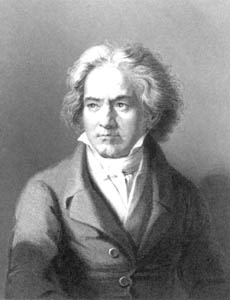![[Metroactive Features]](http://metroactive.com/features/gifs/feat468.gif)
[ Features Index | Silicon Valley | Metroactive Home | Archives ]
Center for Beethoven Studies
By Allie Gottlieb
LUDWIG VAN BEETHOVEN, "the creative genius whose music speaks to the hearts and minds of all humanity," was a very cranky and short man. (He was an average 5-foot-4 man of his times.) Despite rumors, he apparently did not have syphilis. But he did have lead poisoning. The latter may have made him cranky, deaf and (finally) dead. These are things one learns at the Ira F. Brilliant Center for Beethoven Studies at San Jose State University.
The Brilliant Center--located nowadays in a trailer on the school's campus, until it moves to the new city/San Jose State University library in June--claims to have the only collection in North America that's all Beethoven, all the time. The museum's favorite boast, however, is a lock of hair that some huge fan named Ferdinand Hiller lopped off the composer's head while he lay dead in 1827. This creepy and intriguing display has inspired a book and, according to one of the museum's historians, many a pilgrimage to SJSU by curious Beethoven freaks.
The lock of hair has its own little history, which includes having been "property of an unknown Jew" in 1943. It has been examined by a "conservator," sealed and resealed in a locket, used as currency to help Jews escape from Nazis during World War II, auctioned off, counted (the original 582 strands have become 422) and tested for evidence of syphilis (which would have been indicated by traces of mercury used at the time to treat the VD), genius, irritability and glucose disorders. Interestingly, shampoo is not used in hair care in this case, and no one is talking openly about cloning Beethoven despite the obvious opportunity the hair presents. (It even came with bits of scalp attached.)
Beethoven's hair is actually somewhat of a distraction, according to my dad, a classical-music buff and author of academic journal essays on composers. "I have no fascination for the hair relic which is in the museum, which seems an abomination to worship because I'd rather show awe at the spirit of Beethoven's composed music, not the remnants of his decomposition," says my dad, Steve Gottlieb. The hair, for example, can't tell anyone that "in his final quartets and the piano Sonata op. 111, for instance, Beethoven's romantic strain transcends the classical form and moves sonata form into a fuller romantic realm."
Nevertheless, the hair is the only item on display year-round. Other pieces in the museum, such as bronze busts of Beethoven with his wacky punk-rock coif still intact, rotate periodically. When I stopped by in January, the museum featured a "life mask" mold taken of the constantly grimacing composer's face while he was alive and a "death mask" taken, obviously, after that. The death mask had sunken pockets revealing where bone fragments were removed from Beethoven's head for study. When you're famous, everybody wants a piece of you.
The Beethoven collection also includes more than 300 first editions and 1,900 early editions of Beethoven's scores--and more than 3,500 books about his life and times. It's got Beethoven recordings, stamps, a 1795 Dulcken fortepiano and an original 1827 Viennese fortepiano made by a guy who studied under the guy who made Beethoven's favorite pianos.
Certain displays touch some museum visitors deeply. Take, for instance, a letter Beethoven wrote to his brothers Karl and Johann in 1802. He was growing deaf and depressed at the time. "Ah, how could I possibly admit an infirmity in the one sense which ought to be more perfect in me than in others," the modest brother wrote in a document that's called the Heiligenstadt Testament. "I would have ended my life--it was only my art that held me back. ... So I endured this wretched existence."
Beethoven's epiphany, that his ability to create gives him a reason to withstand the pain of his physicality, spoke to one emotional visitor. "I've never seen a man-person cry really, really, really loud before," recalls music historian Beth Fleming, who acted as interim curator recently while curator Patricia Stroh and director William Meredith were away. "He was standing in front of the letter."
Fleming says Beethoven's hair, being literally a piece of him, is what brings most folks by. "Some people are so moved by his music," she says, "but they don't really experience the man until they come here."
Favorite Local Collections
Rite of Pez-age: The Museum of Pez Memorabilia in Burlingame.
The Hole Truth: Lou's Living Donut Museum in San Jose.
Composing a Life: The Ira F. Brilliant Center for Beethoven Studies at San Jose State University.
Waste Not: The Garbage Museum in Milpitas.
Lofty Ambitions: The Wings of History Museum in San Martin.
High-Tech Hit Parade: The Intel Museum in Santa Clara.
History Lesson: The Japanese-American Museum of San Jose.
Beyond the Doily: The Lace Museum in Sunnyvale.
Museums: A complete guide to local museums.
[ Silicon Valley | Metroactive Home | Archives ]
Copyright © Metro Publishing Inc. Metroactive is affiliated with the Boulevards Network.
For more information about the San Jose/Silicon Valley area, visit sanjose.com.
![]()

Composing a Life
Ira F. Brilliant Center for Beethoven Studies Hours: Mon-Fri, 1-5pm. Admission: Free. Modular A, 10th and San Fernando streets, San Jose State University; 408.924.4590. www.sjsu.edu/depts/beethoven/
Send a letter to the editor about this story to letters@metronews.com.
From the March 13-19, 2003 issue of Metro, Silicon Valley's Weekly Newspaper.